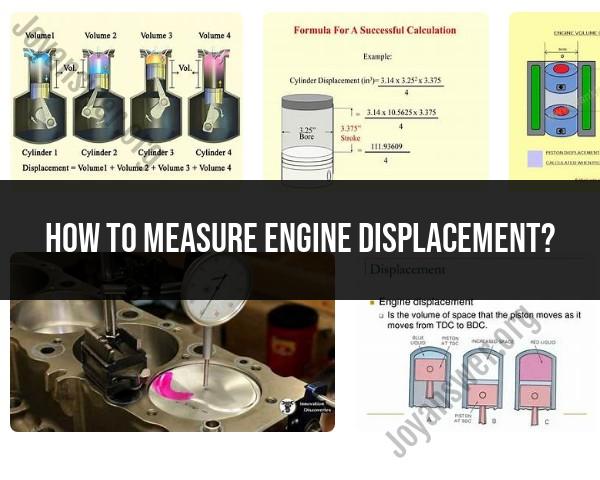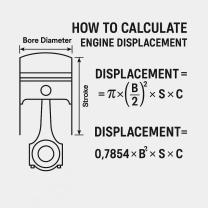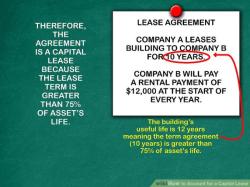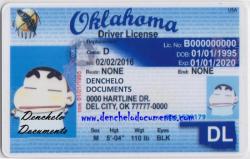How to measure engine displacement?
Engine displacement, also known as engine size, is a measure of the total volume of all the cylinders in an internal combustion engine. It is commonly expressed in cubic centimeters (cc) or liters (L). Engine displacement is a critical factor in determining an engine's power and performance. Here's how you can measure engine displacement:
Method 1: Bore and Stroke Measurements
Identify Bore and Stroke:
- Bore (B): Measure the diameter of one of the engine cylinders. This is the distance from one side of the cylinder wall to the other, passing through the center of the cylinder.
- Stroke (S): Measure the distance the piston travels up and down within the cylinder. It's the distance from the top (TDC - Top Dead Center) to the bottom (BDC - Bottom Dead Center) of the cylinder.
Use the Formula:
The engine displacement () can be calculated using the following formula:
(pi) is approximately 3.1416.
Example:
If the bore is 80 mm, the stroke is 75 mm, and the engine has 4 cylinders:
Calculate this to find the engine displacement in cubic millimeters.
Method 2: Using Manufacturer Specifications
Check the Vehicle's Documentation:
- Vehicle manuals, manufacturer specifications, or online resources often provide the engine displacement directly.
Look for Engine Codes:
- Engine codes, usually found on the engine itself or in the vehicle's documentation, can be cross-referenced with online databases or manufacturer information to determine engine displacement.
Use VIN (Vehicle Identification Number):
- The VIN may contain information about the vehicle, including the engine size. The eighth digit in the VIN is often used to identify the engine.
Method 3: Measuring Cylinder Volume
Calculate Cylinder Volume:
- Measure the diameter (bore) and height (stroke) of one cylinder.
- Calculate the volume of one cylinder using the formula for the volume of a cylinder: , where is the radius (half of the bore diameter) and is the stroke.
Multiply by the Number of Cylinders:
- Multiply the volume of one cylinder by the number of cylinders in the engine.
Example:
- If the bore is 80 mm, the stroke is 75 mm, and there are 4 cylinders:
These methods should help you measure engine displacement accurately. Method 1 is more precise, but Method 2 can be quicker and easier if the information is readily available.
How can one measure engine displacement?
Engine displacement is a measure of the volume swept by the pistons in an internal combustion engine. It is typically measured in cubic centimeters (cc) or liters (L), and it is a key factor in determining the power and torque of an engine.
There are two main methods for measuring engine displacement:
Method 1: Using the Cylinder Bore and Stroke
Measure the cylinder bore: The cylinder bore is the diameter of the cylinder. You can use a caliper to measure the bore diameter across the piston ring grooves.
Measure the stroke: The stroke is the distance the piston travels from top dead center (TDC) to bottom dead center (BDC). You can measure the stroke using a dial gauge or by removing the cylinder head and measuring the distance between the piston top and the crankshaft.
Calculate the displacement: Once you have the bore and stroke, you can calculate the displacement using the following formula:
Displacement = (Bore/2)² * π * Stroke * Number of Cylinders
Method 2: Using the Engine Displacement Formula
You can also use the engine displacement formula to calculate the displacement without measuring the bore and stroke. This formula is typically used for engines with a known bore and stroke or for engines where the bore and stroke are difficult to measure.
The engine displacement formula is:
Displacement = (π/4) * Bore² * Stroke * Number of Cylinders
Where:
- Bore is the cylinder bore in inches
- Stroke is the stroke in inches
- Number of Cylinders is the number of cylinders in the engine
Once you have calculated the displacement, you can convert it to cubic centimeters (cc) or liters (L) using the following conversion factors:
- 1 cubic inch (CID) = 16.3871 cubic centimeters (cc)
- 1 liter (L) = 1000 cubic centimeters (cc) = 61.0237 cubic inches (CID)












